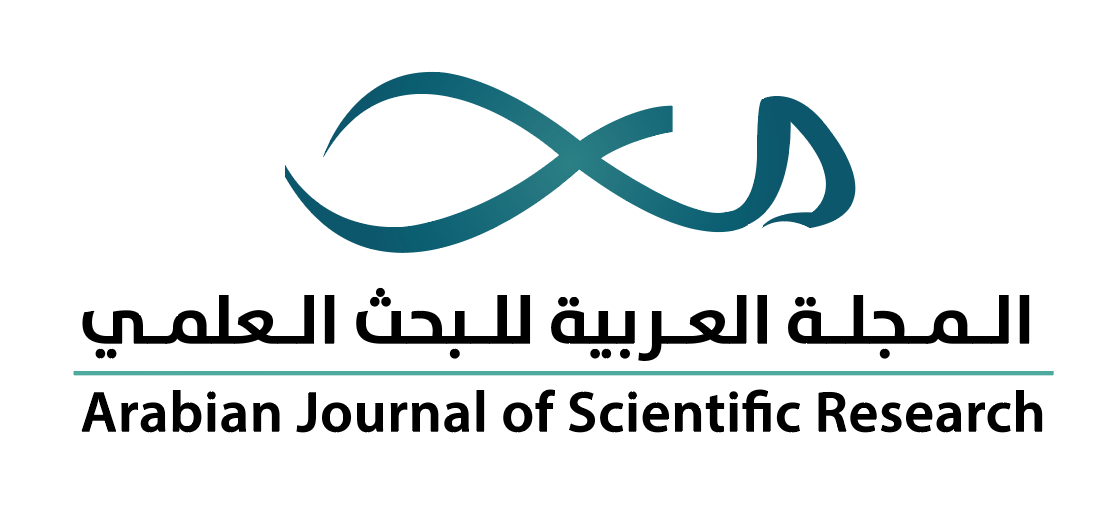-
oa تقييم فاعلية المبيدات الحيوية والمبيدات الكيميائية ومستخلص بذور السبحبح على حشرة مَنّ الباقلاء الأسود (Aphis fabae) — مختبريّاً وحقليّاً
- Source: Arabian Journal of Scientific Research-المجلة العربية للبحث العلمي, Volume 5 (2024), Issue 2, Oct 2024, 9
-
- 10 June 2024
- 25 August 2024
- 31 October 2024
Abstract
الملخص
أجريت دراسة مختبرية وحقلية في مختبرات قسم وقاية النبات في كلية الزراعة بجامعة تكريت خلال عام 2019. الغرض من الدراسة هو تقييم فاعلية المبيدين الأحيائيين (Verticillium lecanii 2% A.S.) Varunastra و،(Hirsutella thompsonii 2% A.S.) Almite والمبيد الكيميائي Levo (Oxymatrine 2.4%)، ومستخلص بذور السبحبح Melia azdirach على حشرة مَنّ الباقلاء الأسود Aphis fabae، وطُبِّقت تجارب البحث بواسطة التصميم العشوائي الكامل (RCBD). بيّنت نتائج الدراسة تبايناً في نسبة الموت لحشرة مَنّ الباقلاء الأسود تبعاً لنوع وتركيز المبيد المستخدم وطول فترة المعاملة. إذ أعطت معاملة توافق مبيد الليفو مع فطر V. lecanii أعلى نسبة قتل بالتركيز15 ppm ؛ إذ بلغت نسبة القتل بمتوسط %97.10 يليه في التأثير معاملة مبيد الليفو عند التركيز ppm 30 ؛ إذ بلغت نسبة القتل %92.76. وبَيّنت نتائج التحليل الإحصائي أن هناك اختلافات معنوية في متوسطات التداخل بين المبيدات والفترات؛ إذ أظهرت الفترة ما بعد 72 ساعة أعلى قيمة بلغت 74.76%، وتلتها بالتأثير الفترة ما بعد 48 ساعة؛ حيث بلغت 35.2%، وجاءت في الأخير الفترة ما بعد 24 ساعة؛ إذ بلغت %11.86. كذلك أوضحت النتائج تفوُّق معاملة توافق مستخلص السبحبح الكحولي والمبيد الحيوي H. thompsonii عند التركيز %6 للمستخلص؛ حيث أعطت أعلى نسبة قتل لحشرة مَنّ الباقلاء الأسود A. fabae بعد 72 ساعة؛ فقد بلغت 84.05%، ويليه في التأثير معاملة توافق مستخلص السبحبح الكحولي والمبيد الحيوي V. lecanii عند التركيز %9 للسبحبح بعد 72 ساعة؛ حيث بلغ متوسط نسبة القتل 78.26%، وانخفضت نسبة القتل في معاملة التوافق بين مستخلص السبحبح المائي والمبيد الحيوي V. lecanii عند التركيز %3 للمستخلص بعد 72 ساعة؛ حيث بلغ متوسط نسبة القتل %52.17. وبيّنت نتائج التحليل الإحصائي تبايناً معنويّاً في متوسطات التداخل بين الفترات ومستخلص السبحبح الكحولي والمائي حيث أعطت الفترة ما بعد 72 ساعة أعلى قيمة؛ حيث بلغت %70.80 حشرة، تليها الفترة ما بعد 48 ساعة؛ إذ أعطت قيمة بلغت %31.52 حشرة، وانخفضت القيمة في الفترة ما بعد 24 ساعة؛ حيث أعطت قيمة بلغت %10.50 حشرة.
A laboratory and field study was conducted in the laboratories of the Plant Protection Department at the College of Agriculture at Tikrit University during the year 2019. The study aimed at evaluating the effectiveness of the two biopesticides Varunastra (Verticillium lecanii 2% A.S.) and Almite (Hirsutella thompsonii 2% A.S.), the chemical pesticide Levo (Oxymatrine 2.4%), and Melia azdirach seed extract on the black bean aphid Aphis fabae. The research experiments were applied using a randomized complete block design (RCBD). The results of the study showed a variation in the death rate of the black bean aphid depending on the type and concentration of the pesticide used and the length of the treatment period. The compatibility treatment of Levo pesticide with the V. lecanii fungus at concentration 15 ppm achieved the highest killing rate of 97.10%. This was followed in effect by treatment with the Levo pesticide at a concentration of 30 ppm, which resulted in a killing rate of 92.76%. The statistical analysis showed significant differences in the averages interaction between pesticides and time periods. After 72 hours, the highest value was recorded at 74.76%, followed by 35.2% after 48 hours. The lowest effectiveness was after 24 hours with a rate of 11.86%. Moreover, the results showed the superior compatibility treatment of alcoholic azdirach extract and the biopesticide H. thompsonii at a concentration of 6% of the extract, giving the highest percentage of killing the black bean aphid, A. fabae, after 72 hours, reaching 84.05%. This was followed by a treatment that matches the alcoholic safflower extract and the biocide V. lecanii at a concentration of 9% azdirach, which also showed significant effectiveness after 72 hours with an average murder rate of 78.26%. The killing rate decreased in the combination treatment of azdirach extract and the biopesticide V. lecanii at a 3% concentration after 72 hours., resulting in an average killing rate of 52.17%. The statistical analysis revealed significant differences in the averages of the interactions between the time periods and the alcoholic and aqueous extracts of azdirach: after 72 hours giving the highest killing rate of 70.80% of the insects, followed by 31.52% after 48 hours, then decreased to 10.50% insect after 24 hours.


